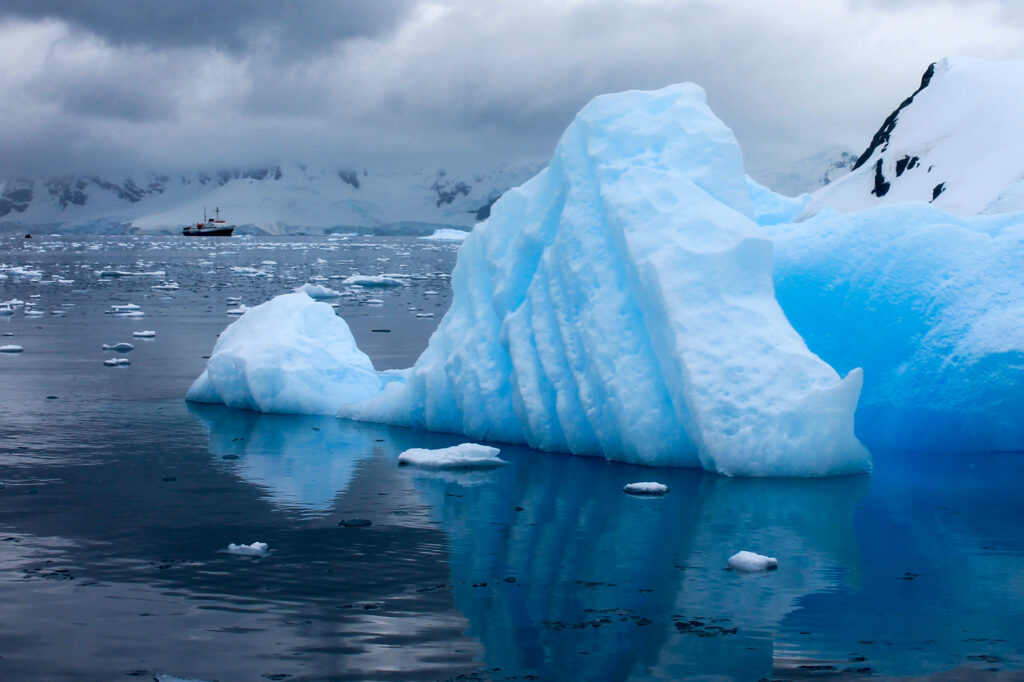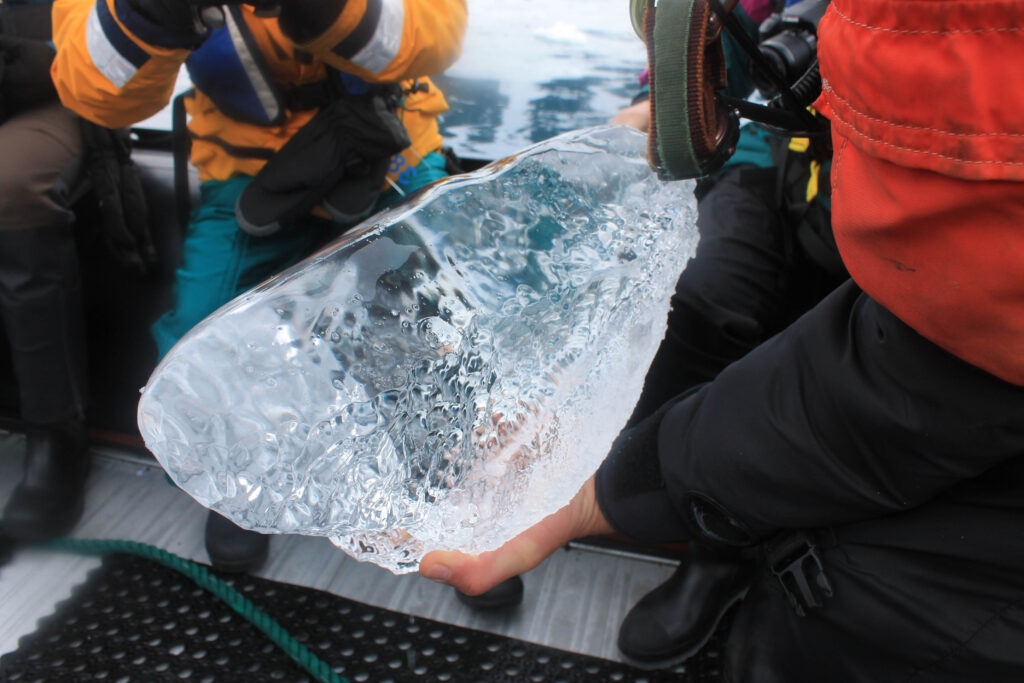The next day, I awake to feel some lingering effects of the vodka and drinking that followed back on the boat. The bottles of Malbec that I’d smuggled on board having been put to good use. Yet this was mitigated by some sense of pride that I’d got drunk on this far flung continent. And knowledge that later today the shock of a plunge into Antarctic waters was bound to put me to rights.
We’d already made anchor, and after another breakfast of unnecessary (but irresistible) size, I stepped out to take in our surroundings. We’d already seen some incredible places on this voyage, but this one was spectacular. We’d entered Paradise Bay. A large natural harbour, it’s water flat, and surrounded by walls of pure white. Blocks of ice that had been shaven away gently sat in the water. It had more serenity than any spot on our journey so far.
.
Some people had the luck to call this their temporary home. The Argentine research base Brown Station was nestled here, its red wooden walls bright against the snowy surroundings, and its blue and white pastel roof a small piece of patriotism that blended in neatly with the surroundings. Directly outside its front door, the sweeping panorama of the bay. It would have been great to chat to the residents here about the pleasure of their morning’s coffee, or how it felt to be severely outnumbered by the true residents, the hundreds of gentoo penguins that shared their plot of land. But the main entertainment was a steady trudge up a hill before sledging down. There was no need for a sledge, because well-padded ski trousers give you all the cushioning you need. The penguins remained nonchalant to our games.
We then took the zodiacs out into the middle of the bay, and approached the glacier walls. Weaving by the offshoots of ice. White, blue, and transparent growlers. At this spot I could have stayed all day. Quite possibly if the research station was a man down for the season you could have signed me up for 6 months. I took some of my favourite photos from the trip here. The deep blue of the icebergs and the perfect reflections. For the return to the boat, we also took a couple of small blocks of growlers within our arms. Smooth, heavy, and taken on board for cocktails later that day.
Later, we arrived at Deception Island. A large dark black rock scattered with snow. There are two active volcanoes in Antarctica. Mount Erebus, located on Ross Island due south of New Zealand. Nearly 4,000km in height, and active enough to have an ever-present lava lake in this land of ice. The other is Deception Island. There is no high peak to this one. Instead, as we skirted the island, a small entrance in the rock opened up, taking us into the large, sheltered bay within the middle of the island. Some 10,000 years ago this bay was formed by a giant eruption from the volcano that now sits gently simmering somewhere below the water’s surface.
As well as animal life, and – hard to believe, given the island’s black and white monochrome backdrop – the greatest number of rare plant species anywhere in Antarctica, it also retains two centuries of human history. It was another whaling station, and some of the old constructions still lie on the island. As a place of research, its time has been more explosive. A 1967 eruption buried a Chilean research station in rock and ash, persuading them to leave the island. The Brits stayed with their research station, only to face a second eruption two years later. The natural fireworks and mud flows that destroyed many buildings, persuading them to abandon the station too. This 1969 eruption also covered a cemetery. What had been the largest in Antarctica, with 35 graves for whalers. Evidence of the dangers of this cruel profession, now further buried beneath our feet.
It was reasonable foresight from the Brits to leave that year because another dramatic eruption followed just one year on in 1970. While the volcanic activity has been quieter since the Chilean’s and Brit’s haven’t been tempted to return. When we visit, there is just small summer presence from Argentinean and Spanish scientists on the island.
We steadily hike up one of the low-lying peaks of the island, to take in a serene view today. Importantly, this was also a chance to increase the body temperature. Shortly afterwards, we lined up on the beach, some of us ready to take a swim.
It would be my first swim. Although possibly the second for half a dozen of the passengers. A couple of days earlier, during an aborted attempt to go Humpback whale watching, one of the zodiacs had capsized. They all fell into the water, including the oldest gentleman onboard. Up until then, for nerves, then he hadn’t left the main boat. After some persuasion, he went on this one, only to experience his own unexpected polar plunge. Is that sods law, or a message that you only make things worse by waiting?
Along these black sands, there were some small spots where the volcanic activity warmed the water. Yet stripping down to swim shorts, the cold air still whipped across my skin. My room-mate was skipping this one, so I passed him my camera and joined others dashing out into the water. Stepping out into the sea, temperatures quickly dipped. Several comically shocked faces attested. The average temperature across the Antarctic waters is below freezing. Due to salinity, sea ice freezes 2-3 degrees below zero. Here, with a little bit of additional warmth, it was barely a couple of degrees above.
The first dip was quick, sharp, tolerable. But returning to the shore I discovered that my room-mate had failed to catch it on camera. I returned, dropping under the water from the neck down, hands raised above the water in triumph. Even if I had started to shiver, and with fists clenched from the effort, I found that in the resulting photo I just looked constipated! It took some hours to warm up again back on the boat.






